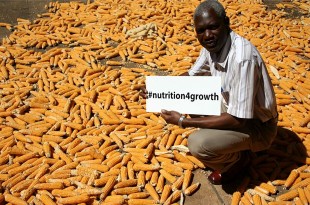
It's a year since the Nutrition for Growth Summit was held in London.
For those of us closely involved in the run up and delivery of the summit it is great to see that there is still some momentum and focus on achieved commitments. As always there might be a danger that after the big splash the long journey of making significant changes becomes more of a ripple.
At the summit significant commitments were made by 92 stakeholders - including 24 governments - to prevent at least 20 million children from being stunted and saving at least 1.7 million lives by 2020.
These commitments include:
- £2.7 billion of new funding for nutrition
- new commitments to scale up research
- the Government of Brazil to host a high level nutrition event at the Rio Olympics in 2016
- an annual global nutrition report to highlight progress against commitments made.
Earlier this week at the London School of Hygiene and Tropical Medicine an anniversary event was held to highlight progress and discuss the way forward to 2020.
Lawrence Haddad made a compelling speech on the importance of the global nutrition report, which will be launched in November this year and will continue to track commitments made last year towards global progress on nutrition. With 35% of child deaths caused by under-nutrition he called it an 'absolute scandal' that we don't have enough data to track progress on nutrition and that only 0.4% of overseas development financing is directed to nutrition.
In their preliminary review of data for the global nutrition report, the review team have initial findings that show only 84 out of 150 low income countries have comparable baseline data on child nutrition status - stuntning, wasting, overweight and early breastfeeding - and of those only 2 are on track against these four key World Health Assembly targets for child nutrition improvements by 2020. A very sobering message and thought.

Nick Dyer, from DFID and Michael Anderson, from Children’s Investment Fund Foundation (CIFF) spoke about the importance of delivery and keeping up the momentum. As we know most of the battle to reduce stunting will not be tackled by pilots or innovative approaches but will be about the science of delivery and scale up. It's a rare discussion in development, but how to manage large programmes well and scale them up will be the main challenge, and yet much of the dialogue still focuses on finding 'innovative or technological' solutions.
Arti Ahuji, the Secretary of the Ministry of Women and Child Development in Odisha state in India spoke compellingly of just that - the everyday challenge of providing nutrition and child development services to 5 million children in her state via 71,000 community nurseries. She highlighted how they have reduced stunting in Odisha through systems strengthening, community monitoring, a focus on the first 1000 days of a child's life and high level accountability to the Chief Minister.
Roberto Jaguaribe, Ambassador of Brazil to the United Kingdom also spoke about how Brazil has managed to tackle undernutrition as a 'development issue', not a technical one. He highlighted the importance of under nutrition resulting from broader issues such as trade and agriculture policies. The Brazilian hosted event in 2016 will focus on the importance of research linkages and ensuring healthy access to food.
The event was chaired by Jeff Waage from the Global Panel on Agriculture and Food Systems for Nutrition, launched last June.
The audience asked some interesting questions including ones about the level of future ambition in terms of commitments, tracking how far the 'matching funds' commitment made by DFID and CIFF had moved and what are new ways to politically engage a broader audience in the challenge to tackle under nutrition.
DFID also launched a report that highlights how far we have moved on commitments we made last June, including tracking on spend that shows a 58% increase in nutrition specific spend between 2010-12 and highlights that we now have nutrition programmes in 37 countries.
Personally, it was reassuring to see a stock take happen a year later and hear progress on tracking commitments. Let's now wait till November to hear an independent evaluation of how we have all done on actually making a difference on the real goals of reducing stunting and undernutrition.
Keep in touch. Sign up for email updates from this blog.

Recent Comments